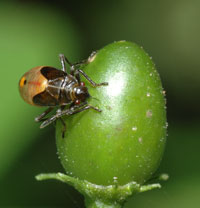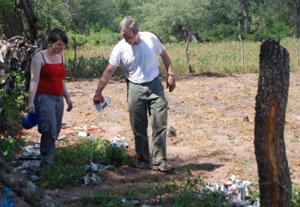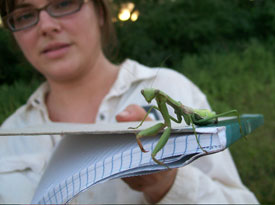 |
|||||||
| Biology Home | News | Calendar | Make a Gift | UW Alumni | |||||||
|
Spring 2009 | Return to issue home
Why Chilies Are Hot By Kristy Brady
It turns out that we may have a fungus to thank for spicy chili peppers. In their native range in Bolivia, many chilies are spicy, or pungent, whereas some are as non-spicy as a bell pepper. In the field, the only way to tell if a chili is spicy is by tasting it: pungent and non-pungent fruits look identical. But why are only some chilies spicy? Biology associate professor Josh Tewksbury’s lab—including biology graduate students Noelle Machnicki and David Haak—is working earnestly to answer this question. The lab’s current hypothesis is that chilies are spicy in order to repel a pervasive fungus. Because even though chili spiciness is variable, Machnicki notes that “almost all chilies have a fungus on them, and a good number of them have a particular fungus called Fusarium on them.” Machnicki and colleagues in the Tewksbury lab measured a strong correlation between the extent of fungal infection in chilies and the proportion of pungent plants in a population. A follow-up study to this observation showed that a seed’s rate of fungal infection is a good indicator of its ability to germinate. And although pungent chilies experience high rates of fungal infection, seeds of pungent plants escape most infection and therefore any significant decline in germination rates. Fungal growth on non-pungent seeds, however, is two to three times the level seen on pungent seeds. Spiciness in chilies is caused primarily by the compound capsaicin; so this observation hints that capsaicin may protect seeds by inhibiting fungal growth. To test this Machnicki gathered Fusarium specimens and chilies from the wild and brought them back to the lab to test how Fusarium is affected by capsaicin. She created a “false-fruit media” that is nutritionally identical to a chili, but to which she can vary the amount of capsaicin added. She then measured the growth rate of different Fusarium isolates on media with capsaicin concentrations ranging between 0 and 16 mg/g. 16 mg/g is in the range of hot chilies such as habañeros and scotch bonnets; Fusarium response to capsaicin concentrations above 16 mg/g plateaus, so it makes a good cut-off point. (Capsaicin is also very expensive—$119 per gram—so Machnicki is prudent with her use of it.) Machnicki’s experiment yielded several interesting findings. First, Fusarium strains from really pungent chilies grow better in the presence of high capsaicin levels than Fusarium strains from weakly pungent or non-pungent chilies, indicating Fusarium strains are locally adapted to the spiciness of their host. Second, capsaicin tolerance exacts a price: Fusarium strains adapted to high levels of capsaicin grow more slowly in a non-pungent environment than do less-tolerant strains. Lastly, and most importantly, capsaicin inhibits Fusarium growth. Which begs the question: If capsaicin checks Fusarium growth, why aren’t all chilies hot? When Being Hot Hurts In the wild, the proportion of non-pungent plants in a population increases along a decreasing precipitation gradient, suggesting non-pungency is advantageous in drier climates. An experiment in the Department of Biology’s greenhouse showed that non-pungent plants do, in fact, fare better when faced with a lack of water. When water-stressed, non-pungent plant seed production drops by 70-75%, but pungent plant seed production drops by 95% or more. Why pungent and non-pungent plants respond differently to drought is still unclear, but biology graduate student Haak thinks non-pungent plants may possess greater control over how they utilize limited resources when they are water-stressed.
Haak developed this hypothesis after reading a recent paper by biology Professor Keiko Torii on “too many mouths.” Torii’s research on Arabidopsis thaliana showed that the functional loss of a gene called “too many mouths” led to increased numbers of stomata. Stomata are pores on the surface of a leaf that open up to take in carbon dioxide for photosynthesis and emit oxygen, a photosynthetic byproduct. While open, stomata also inevitably lose water through evaporation. Such water loss could be problematic in areas that are hot and dry, such as those areas in Bolivia where non-pungent plants outnumber pungent plants in wild chili populations. Haak imagines that having more stomata may afford non-pungent plants greater control over how wide their stomata open and how long they are open for. “To get the same amount of gas exchange with fewer stomata,” he explained, “a plant would need to have its stomata open longer or wider or both.” He is currently designing an experiment to test this hypothesis. Pungency does not repel all herbivore threats, either. Ants actually prefer spicy seeds to non-spicy seeds because spicy seeds have thinner seed coats along the longest axis of the seed. It stretches so thin here that ants can chew through the seed coat and eat the seed’s endosperm, the nutritious tissue that fuels germination and without which the seed dies. Non-pungent plants have thicker seed coats, which protect the endosperm from ant predation. Lignin is the primary constituent of seed coats. Interestingly, lignin and capsaicin are products of the same biochemical pathway; lignin is produced near the middle of the pathway and capsaicin near the end. Knowing this, Haak suspected that the difference in seed coat thickness between pungent and non-pungent plants might be because pungent plants divert more biochemical intermediates to producing capsaicin instead of lignin. But an experiment Haak conducted to test this hypothesis proved otherwise: Pungent plants not only produce more capsaicin than non-pungent plants, they also produce more lignin. “The whole biochemical pathway is up-regulated in pungent plants,” Haak explained. So why do pungent plants have thinner seed coats? “All the extra lignin is deposited at the ends of the seeds, where it doesn’t do any good protecting the seed from ant predation.” Many Hands Make Light(er) Work Though the details of their research differ, Machnicki and Haak seek to answer a common question: what are the selective pressures that caused the evolution of both pungent and non-pungent fruits? In other words, why are some chilies eye-wateringly, mouth-searingly hot, and others not? Their complementing areas of expertise mean their approach is more holistic; thus, they are more likely to piece together an accurate explanation for the evolution of spiciness. It also means they can work together on large-scale experiments.
Currently Noelle and Haak are collaborating on a large common garden reciprocal transplant experiment in Bolivia. To start they collected seeds from pungent plants growing in predominantly pungent populations and seeds from non-pungent plants growing in predominantly non-pungent populations. They grew plants from these seeds in a greenhouse and then transplanted both pungent and non-pungent plants together in two sites—one in the largely pungent region and the other in the largely non-pungent region. The results of this reciprocal transplant will help Haak determine if pungent and non-pungent plants are differentially adapted to the environment where they are predominantly found and the genetic basis for any adaptive differences. Machnicki is using these gardens to investigate how Fusarium is dispersed. Field observations have revealed a community of insects that feeds on chilies. Some of these insects insert a proboscis into the chili to suck out the seed endosperm and the fungus grows in and around the hole left by the insect. Machnicki is wondering if Fusarium travels on the insect’s proboscis and is inserted into the chili as the insect feeds, or whether the hole left by the proboscis simply prepares an easy infection site for the fungus. To answer this, Machnicki has designed an experiment to compare the infection rate of chilies bagged to prevent insects from puncturing the fruits versus chilies left un-bagged and exposed to insects. In addition, she will also artificially create holes using a sterile needle in some bagged and un-bagged chilies to test whether a hole in the fruit makes infection easier for the fungus. So the question of why some chilies are hot is an ongoing project. Machnicki and Haak’s research demonstrates that biological systems are fascinatingly complex, and untangling the many intertwining factors takes time and numerous experiments. But the chili system is a tractable one, making the likelihood of further successful experiments excellent. And according to Haak the chili system has one distinct benefit over most other research systems. As he puts it, “How many biologists get to eat the fruits of their labor?” Visit the Tewksbury lab Web site to learn more about Machnicki and Haak's research and how you can help support it. *Photo courtesy of the Tewksbury lab Spring 2009 | Return to issue home | |||||||
|
|||||||


